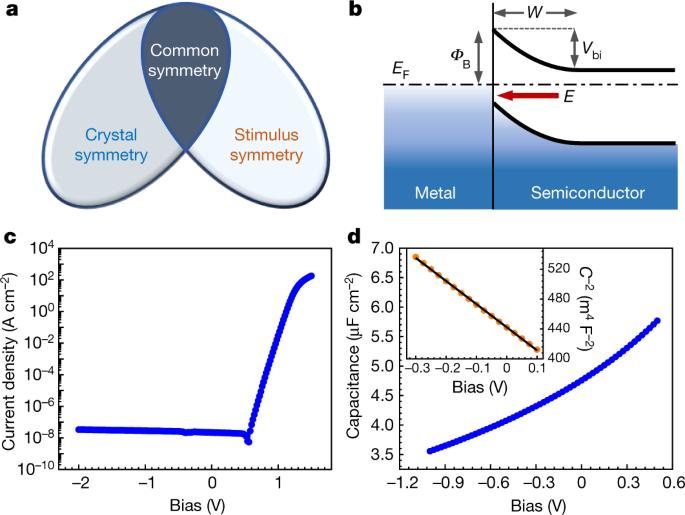界面极性对称诱导的压电和热释电效应
IF 48.5
1区 综合性期刊
Q1 MULTIDISCIPLINARY SCIENCES
引用次数: 90
摘要
几十年来,异质结构中的界面一直是凝聚态物理学关注的焦点,因为它们具有大量独特的现象,如整流效应1、光伏效应2、量子霍尔效应3和高温超导效应4,而且在当今的技术设备中发挥着至关重要的作用。然而,界面的对称性调制及其产生的效应在很大程度上被忽视了。在这里,我们展示了源于异质结构界面带弯曲的内置电场会诱导其中的极对称性,从而产生新的功能,包括压电性和热释电性,即使组成材料是中心对称的。我们研究了经典的界面,即由贵金属和中心对称半导体(包括掺铌的氧化锶钛晶体、掺铌的二氧化钛晶体、掺铌的氧化锶钛钡陶瓷和硅)形成的肖特基结。耗尽区的内置电场会在半导体中产生极性结构,并产生巨大的压电和热释电效应。特别是,界面的热释电系数和优点系数比传统的块状极性材料大一个数量级以上。我们的研究丰富了异质结构界面的功能,为实现能量传导提供了一种独特的方法,超越了固有对称性带来的传统限制。研究表明,金属和中心对称半导体界面上的内置电场可诱导半导体中的极性结构,并产生巨大的压电和热释电效应。本文章由计算机程序翻译,如有差异,请以英文原文为准。

Piezoelectric and pyroelectric effects induced by interface polar symmetry
Interfaces in heterostructures have been a key point of interest in condensed-matter physics for decades owing to a plethora of distinctive phenomena—such as rectification1, the photovoltaic effect2, the quantum Hall effect3 and high-temperature superconductivity4—and their critical roles in present-day technical devices. However, the symmetry modulation at interfaces and the resultant effects have been largely overlooked. Here we show that a built-in electric field that originates from band bending at heterostructure interfaces induces polar symmetry therein that results in emergent functionalities, including piezoelectricity and pyroelectricity, even though the component materials are centrosymmetric. We study classic interfaces—namely, Schottky junctions—formed by noble metal and centrosymmetric semiconductors, including niobium-doped strontium titanium oxide crystals, niobium-doped titanium dioxide crystals, niobium-doped barium strontium titanium oxide ceramics, and silicon. The built-in electric field in the depletion region induces polar structures in the semiconductors and generates substantial piezoelectric and pyroelectric effects. In particular, the pyroelectric coefficient and figure of merit of the interface are over one order of magnitude larger than those of conventional bulk polar materials. Our study enriches the functionalities of heterostructure interfaces, offering a distinctive approach to realizing energy transduction beyond the conventional limitation imposed by intrinsic symmetry. A built-in electric field at the interface of metals and centrosymmetric semiconductors is shown to induce polar structures in the semiconductors and generate substantial piezoelectric and pyroelectric effects.
求助全文
通过发布文献求助,成功后即可免费获取论文全文。
去求助
来源期刊

Nature
综合性期刊-综合性期刊
CiteScore
90.00
自引率
1.20%
发文量
3652
审稿时长
3 months
期刊介绍:
Nature is a prestigious international journal that publishes peer-reviewed research in various scientific and technological fields. The selection of articles is based on criteria such as originality, importance, interdisciplinary relevance, timeliness, accessibility, elegance, and surprising conclusions. In addition to showcasing significant scientific advances, Nature delivers rapid, authoritative, insightful news, and interpretation of current and upcoming trends impacting science, scientists, and the broader public. The journal serves a dual purpose: firstly, to promptly share noteworthy scientific advances and foster discussions among scientists, and secondly, to ensure the swift dissemination of scientific results globally, emphasizing their significance for knowledge, culture, and daily life.
 求助内容:
求助内容: 应助结果提醒方式:
应助结果提醒方式:


